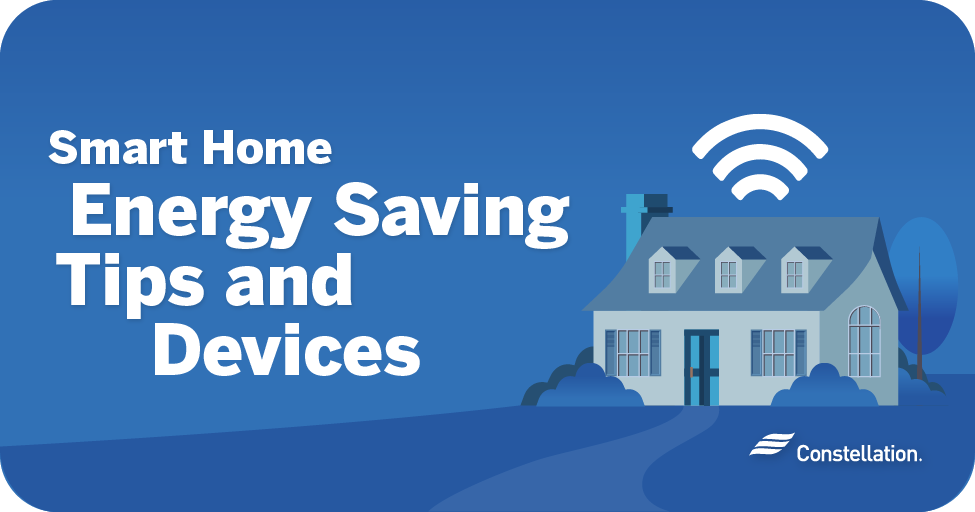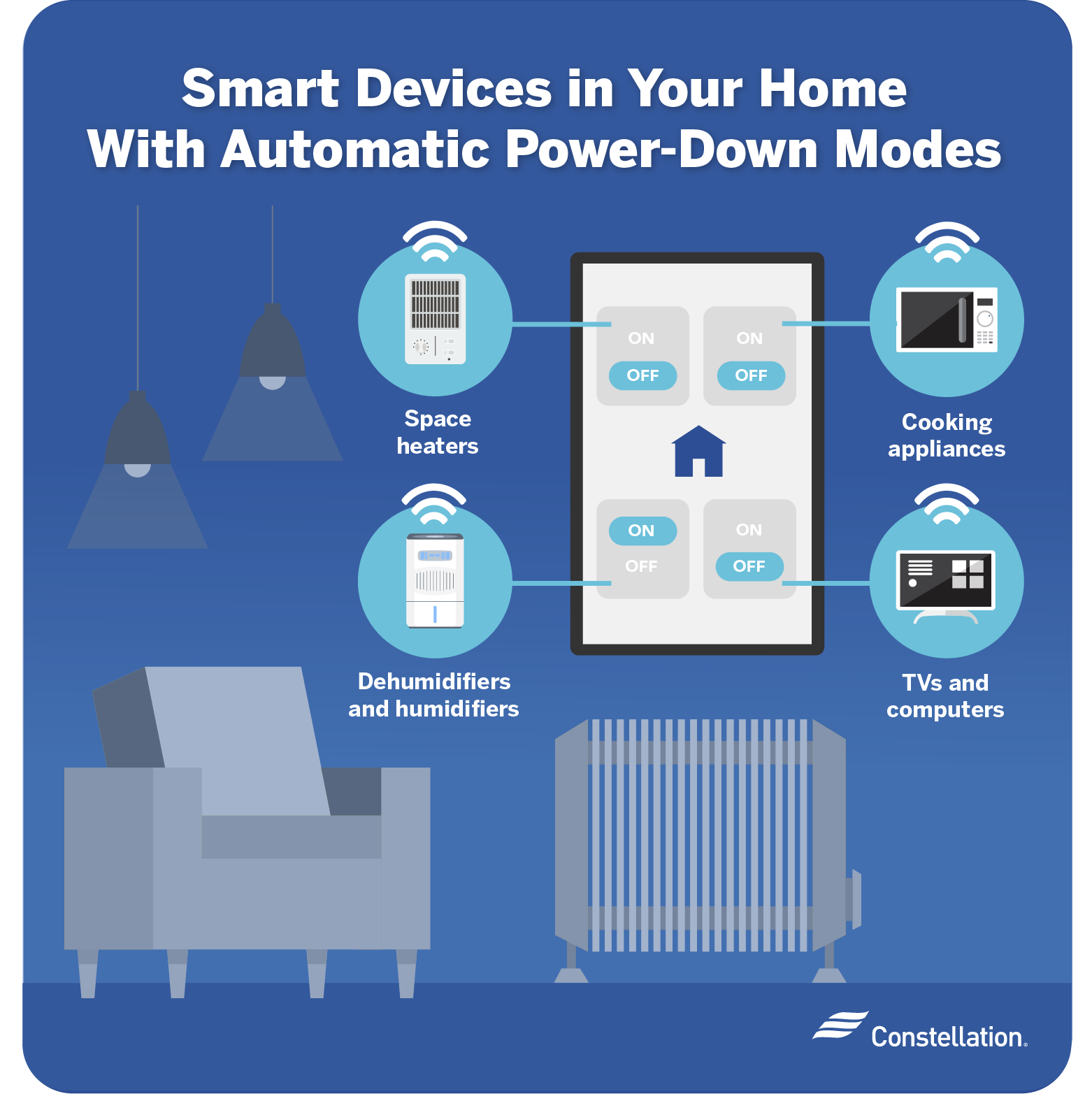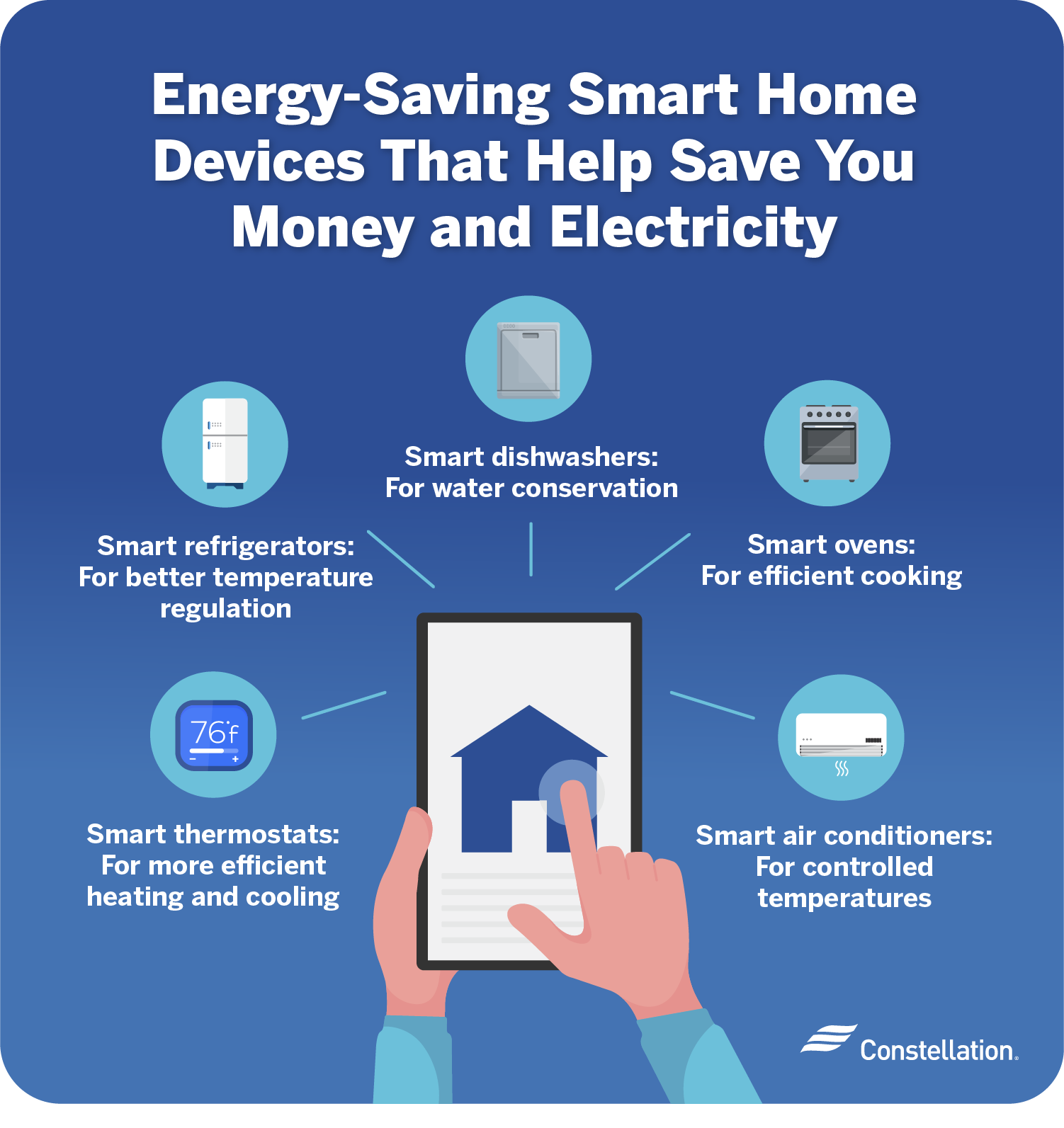
- Category:
Home Energy Savings -
Last updated:
August 15, 2022
Smart Home Energy Saving Tips and Devices
Whether it’s switching the lights off when leaving a room or turning off electronics and appliances when not in use, there are simple habits that can help you conserve energy. However, by investing in smart home energy saving devices, you can automate many of these daily tasks and increase your overall energy savings.
Many homeowners are turning to smart technology to better monitor and control their home’s energy usage, and here’s how you can do the same.
- How smart homes help you save energy
- 7 smart home energy-saving tips
- 5 smart home energy-saving devices
How smart homes can help you save energy
Homes built after 2000 consume the same amount of energy as homes built back in the 1960s, despite being 27% larger on average. In large part, this is because newer homes are more likely to be built with smart-home energy efficiency in mind, including smart-home hubs and appliances.
Smart technology allows homeowners to take control of their energy usage through a variety of smart-home energy-saving strategies. For example, smart-home hubs can turn electronic devices and appliances off when not in use, eliminating standby power loss and improving energy conservation.
New energy-saving devices for smart homes are controlled via smartphone apps, so you can manage and monitor your energy usage from anywhere. These technological advances help increase safety and convenience, as well as offer new strategies for reducing your smart-home energy consumption.
7 smart home energy-saving tips to save money and electricity
Home automation offers a number of benefits, such as allowing you to create energy-saving routines for the most power-hungry appliances in your home. Here are some of the best energy-saving strategies for smart homes that you can use today.
1. Simplify your day by setting smart-assistant routines.
Smart-home assistants like Amazon Echo and Google Home allow you to create daily smart-home routines, scheduling when appliances turn on and off.
For instance, you could set dishwashers to run while you’re out of the house, schedule your coffee machine to turn on and off at the same time every morning, or create a similar routine for any of your other smart kitchen appliances.
Incorporating these routines means you don’t have to worry about forgetting to turn off appliances when they’re not in use, improving both safety and energy-efficiency as a result.
2. Analyze your home’s energy use with smart home-energy apps.
In order to find ways to save energy in your smart home, you’ll first need to know which appliances and devices consume the most energy and when they’re most often in use.
Home-connected apps, such as the DoE’s Home Energy Saver, monitor and analyze energy use to show homeowners which of their appliances are consuming the most power.
3. Lock in your energy price with a fixed-rate plan.
Dishwashers, washing machines and clothes dryers often run at the same time in multiple households across an electrical grid, creating peak demands for energy at certain times of day. When this happens, the price of electricity rises, as well.
A fixed-rate energy plan allows you to lock in your energy rate for the duration of your contract, meaning you can avoid these price fluctuations. To further your savings, you can secure your rate when electricity rates are lowest.
4. Use automatic power-downs to stop appliances from wasting energy.

Many appliances consume energy even when not actively in use. Gaming consoles, standby coffee makers, cable or satellite boxes and any device that can be operated by remote control will consume power when not in use.
If you’re unable to unplug your appliances, using automatic power-down modes prevents inactive appliances and devices from draining energy. If you’re unsure of how much energy an appliance consumes, Energy.gov has a useful appliance energy calculator.
Smart devices in your home that may include automatic power-down modes include:
- Space heaters. Improve your smart-home energy savings by scheduling timers to automatically power down space heaters at certain times of day.
- Cooking appliances. Even when kitchen appliances are not in active use, the displays on microwaves, ovens and refrigerators remain on and consume power. Smart tech can send appliances into power-saving modes, turning off displays when a device or appliance is not in use.
- TVs, computers and gaming consoles. Leaving computers, televisions and gaming consoles on when not in use wastes energy—energy a smart assistant can save by triggering automatic power downs.
- Dehumidifiers and humidifiers. Dehumidifiers and humidifiers are often left to run all the time. Using smart assistants to turn off such devices when no one is home keeps their energy usage down and helps ensure your home stays at a comfortable humidity level.
5. Save energy with voice-controlled smart lighting.
Smart lighting includes any lights that can be controlled by a home’s smart assistant or through the smart light’s phone app. Homeowners can set up energy-efficient timers, motion detectors and dimmers to change the lighting at specific times throughout the day. Once linked to a smart assistant, such lighting can be turned on and off through voice commands.
Smart lights offer other benefits, such as helping to secure and protect your smart home. For example, scheduling lights to come on and off when you’re not home can be part of an automated home security system, deterring burglars by suggesting the home is occupied.
Switching from traditional incandescent light bulbs to energy-efficient LED or CFL bulbs also saves energy. While slightly more expensive than traditional bulbs, LED bulbs last much longer than incandescent lights, making them a wise investment.
6. Consider upgrading to energy-efficient appliances for more energy savings.
Turning off your appliances when they’re not in use helps conserve energy, but to take your energy-savings even further, you can upgrade to energy-efficient appliances. Replacing old, energy-draining appliances with newer, more efficient models can reduce your home’s energy consumption while potentially increasing your property value.
7. Use smart plugs to turn any electrical product into a smart device.
You don’t have to upgrade all of your home’s gadgets, devices and appliances at once. With smart plugs, you can turn any electrical product into a power-saving smart device.
Smart plugs can be controlled from your smartphone or linked to your home assistant. Once installed, the best smart plugs can turn devices on and off while also monitoring each device’s energy use. Smart power strips work in a similar way, making them another worthwhile power-saving device.
5 smart home energy-saving devices

To truly take advantage of smart-home energy savings, it may be necessary to upgrade your home’s technology. If you’re unsure where to start, consider any of the following devices to save electricity at home:
1. Smart thermostats for more efficient heating and cooling
HVAC systems account for 32 percent of the average home’s electricity consumption and have the potential to waste considerable amounts of energy if left running when no one is home. That’s why automated thermostats are important smart-home energy-efficiency tools. A smart thermostat tracks the home’s temperature and adjusts temperatures based on whether the home is occupied.
2. Smart refrigerators for better temperature regulation
Energy-efficient refrigerators save energy by analyzing internal temperatures and adjusting the thermostat accordingly. In addition, some smart fridges make your life easier by allowing you to scan the fridge’s contents from your phone and automatically ordering food when supplies run low.
3. Smart dishwashers for water conservation
Smart dishwashers can be controlled from smartphone apps and scheduled to run at specific times. Newer-model dishwashers also detect leaks and dry dishes much more efficiently with lower energy requirements. New energy-saving technology for homes even allows you to control when appliances operate so you can schedule them to run when energy demand is low.
4. Smart ovens for efficient cooking
With flexible features and built-in Wi-Fi technology, the newest smart ovens expand on the already impressive list of benefits that energy-efficient ovens offer. For example, some smart ovens are even able to notify you when dinner is finished cooking and ready to serve.
5. Smart air conditioners for controlled temperatures
Home connectivity makes it possible for you to control your smart air conditioner by app or voice command, allowing you to set the air conditioner to turn on before you arrive home.
Air conditioning accounts for 15 percent of the average home’s energy consumption, and most air conditioners run more than they should. You can reduce your heating and cooling costs by linking your air conditioner to a smart thermometer for maintaining your ideal home temperature.
Be smart and save more with Constellation
Constellation offers a wide range of smart home devices and accessories that can help conserve energy and keep your home secure, such as thermostats, sensors and security cameras, and smart home hubs.




